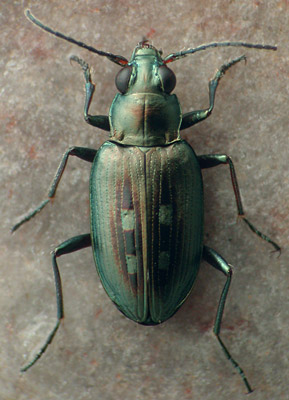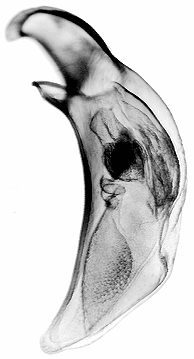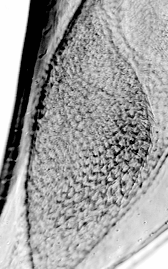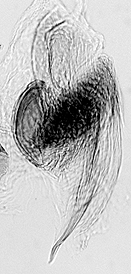Bembidion lapponicum
David R. MaddisonAdult External Characteristics
Elytra with mirrors on interval 3, in most specimens with fainter mirrors on 2 through 5, rarely with very faint mirrors on 6 and 7. The hind anges of the pronotum are prominent, and flare outward; they lack a long basilateral carina. Pronotum with a midlateral seta.
Male Genitalia
Aedeagus wide and short, with one prominent lobe (the "pillow") with large triangular scales. This lobe is visible towards the apex of the aedeagus when the internal sac is in repose.
Comparison with Related Species
Compare with:
B. lapponicum can be difficult to distinguish using external characters from B. velox and B. carinula. The prothorax of B. lapponicum is flatter, with less rounded sides, and broader base with more protruded hind angles, and without the long basilateral carina of B. carinula. Interval 3 of the elytra is generally wider, with the silver spots wider and longer. Legs of B. lapponicum are darker in most specimens. Males of B. lapponicum have a distinctive lobe (called a "pillow"), covered with larger triangular scales, that rests near the tip of the aedeagus when the internal sac is in repose.
Geographic Variation
Specimens in the southern part of the range in North America are larger, with straighter, less-impressed striae, a generally smoother and shinier surface, with mirrors on intervals 2, 4, and 5 generally absent or very faint, and with a relatively narrow interval 3 than most northern specimens.
Lindroth (1962) gives a brief discussion of Palearctic variation.
Geographic Distribution
A Holarctic species, from northernmost Scandinavia throughout much of Russia, south to Mongolian Peoples' Republic, east to Kamtchatka. In North America, from Alaska east to the Anderson River in the North West Territories of Canada, south to scattered localities in Oregon, Wyoming, and central Saskatchewan. It is common in the north of its range in North America, but very rare in the south.
Habitat
On barren sand banks of large rivers, less frequently around small rivers, and rarely around lakes.
Nomenclature
- Bembidium impressum Var. B. lapponicum Zetterstedt 1828. Lectotype male in ZML.
- Bembidium latiusculum Motschulsky 1845
- Bembidium Jenisseense J. Sahlberg 1880
- Bembidium pugetanum Fall 1916
Other Names for Bembidion lapponicum
- Bembidion jenisseense
- Bembidion latiusculum
- Bembidion pugetanum
Title Illustrations

| Scientific Name | Bembidion lapponicum |
|---|---|
| Location | Canada: British Columbia: Hope |
| Sex | Male |
| Image Use |
 This media file is licensed under the Creative Commons Attribution License - Version 3.0. This media file is licensed under the Creative Commons Attribution License - Version 3.0.
|
| Copyright |
© 2004 David R. Maddison

|
About This Page
David R. Maddison

Oregon State University
Page copyright © 1995 David R. Maddison
 Page: Tree of Life
Bembidion lapponicum .
Authored by
David R. Maddison.
The TEXT of this page is licensed under the
Creative Commons Attribution License - Version 3.0. Note that images and other media
featured on this page are each governed by their own license, and they may or may not be available
for reuse. Click on an image or a media link to access the media data window, which provides the
relevant licensing information. For the general terms and conditions of ToL material reuse and
redistribution, please see the Tree of Life Copyright
Policies.
Page: Tree of Life
Bembidion lapponicum .
Authored by
David R. Maddison.
The TEXT of this page is licensed under the
Creative Commons Attribution License - Version 3.0. Note that images and other media
featured on this page are each governed by their own license, and they may or may not be available
for reuse. Click on an image or a media link to access the media data window, which provides the
relevant licensing information. For the general terms and conditions of ToL material reuse and
redistribution, please see the Tree of Life Copyright
Policies.
Citing this page:
Maddison, David R. 1995. Bembidion lapponicum . Version 01 January 1995 (under construction). http://tolweb.org/Bembidion_lapponicum/393/1995.01.01 in The Tree of Life Web Project, http://tolweb.org/











 Go to quick links
Go to quick search
Go to navigation for this section of the ToL site
Go to detailed links for the ToL site
Go to quick links
Go to quick search
Go to navigation for this section of the ToL site
Go to detailed links for the ToL site